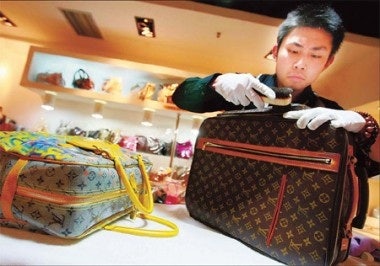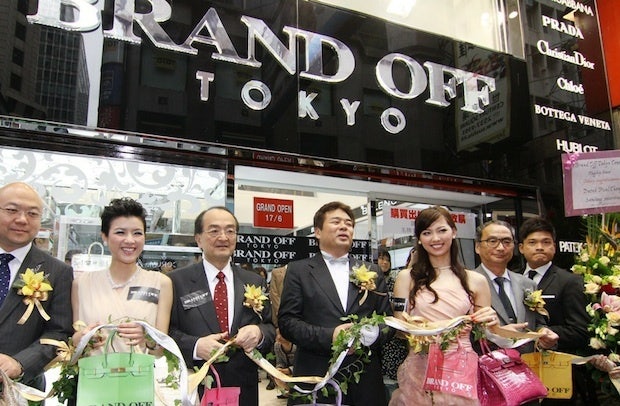"It's Exactly The Same As The Second-Hand Luxury Market In Japan 10 Years Ago"#

What Jing Daily referred to as the "spreading wildfire of luxury second-hand shops in China" last year continues to rage in China's first- and second-tier cities (as well as over the border in Hong Kong). Though China's overall luxury market is expected to show slower overall growth this year compared to 2011, demand from the country's less well-heeled, yet still chicly conscientious, for "almost new" handbags, apparel and accessories are helping chains like Hong Kong's
Milan Station#
and Japan's
Brand Off#
gain extreme popularity.
This growth isn't limited only to handbag and jewelry-focused chains, however, and extends into more male-dominated areas like high-end watches, particularly as changing economic times push some businessmen into the pawnshop. As Jing Daily noted in 2010, luxury watches started to show up in pawnshops in Beijing in the mid-’90s, with pawning activity increasing dramatically since around 2000 and creating big business in the Chinese capital and some of the country’s wealthier cities. Cashing in unwanted luxury gifts is not restricted to pawnshops, though, as it’s also fueled second-hand luxury shops. As As Zhou Ting, director of the Research Center for Luxury Goods and Services at UIBE, said this January, more ultra-wealthy Chinese looking to sell their high-end goods for quick cash means that the second-hand luxury market should be a segment that enjoys huge industry growth this year.
As Zhou added, “[China's] exactly the same as the second-hand luxury market in Japan 10 years ago. After all of these years, the second-hand luxury market in Japan has become relatively mature, with a complete supply chain that is able to procure plenty of top luxury brands.”

However, second-hand stores and shopping weren't always so popular, particularly in China's more fashionable cities. As Shanghai Daily writes this week, when leading Japanese second-hand luxury retailer Brand Off first entered the Chinese mainland last September, it found it highly difficult to make any inroads in a country that considered used products lower in quality and status. But -- perhaps due to a slowing economy and gradually changing consumer attitudes, Brand Off Shanghai store manager Takayuki Shimata told Shanghai Daily that "the business is getting better as our name catches on among bargain-hunters."
Now, Brand Off is looking to join Hong Kong-based competitor Milan Station in expanding in other coastal Chinese cities. Currently, Brand off has two locations in Shanghai, along with six in Hong Kong. Milan Station has five locations in mainland China, as well as 10 in Hong Kong and one in Macau, though it has found its mainland China expansion efforts complicated by the fact that knockoff chains (山寨米兰站) -- going under names like “Milan Fashion,” “Guangzhou Milan Station” and even "Milanstation" -- have become ubiquitous in major Chinese cities.
So, why all the popularity in recent years? As Shanghai Daily sees it, the explosive success of luxury used-goods may be a symptom of a changing — and mildly subversive — perspective among Chinese shoppers, which is creating a “a new breed of luxury shoppers in China -- people with a fashion-conscious bent in a budget-conscious reality who want a showy lifestyle without losing face.” This growing breed mainly consists of young women looking for a cut-price handbag and wealthy customers looking for unused limited editions. As Milan Station chief marketing officer, Tony Chan, told the paper, "We believe that the second-hand luxury goods market is becoming popular in Shanghai and China...Previously, the Chinese thought that buying second-hand goods was inferior and shameful. However, this concept has changed in recent years."

Another reason consumer attitudes are changing is the growing accessibility of overseas travel, which has allowed ever more of urban Chinese to visit places like Japan and South Korea -- where luxury second-hand shops have been around (and popular) for the last two decades at least. As one Chinese second-hand luxury shopper, who observed that she saw these stores "everywhere" on a recent trip to Japan, told Hexun last year, “I visited one [store] that was a six-story building full of second-hand luxury goods, separated into sections...and each item included a certificate of authenticity.” Also, some cashed-up Chinese buyers have fueled the growth of the industry by side-stepping long waitlists for popular, hard-to-get handbags like the Hermès Birkin, dozens of which are readily available at stores lining streets frequented by Mainland tourists in Hong Kong.
No longer as tightly bound by the pressures of buying new, the stylishly smart are opting to sacrifice a thread of quality and spend less, while maintaining the visage of a luxurious lifestyle. Of course, the “buyer beware” mantra still rings true, particularly at the dozens of knockoff Milan Station clones and fly-by-night operations in cities throughout China. While rigorous examinations of authenticity can curb the chance of buying a fake, the risk is forever present. However, that is one risk the Chinese luxury bargain hunter is becoming increasingly willing to take.
